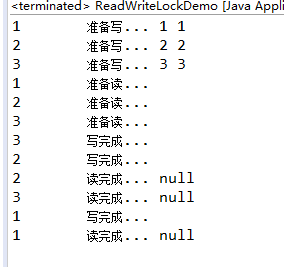独占锁
又叫写锁,指该锁只能被一个线程所持有。Java 中 ReentrantLock 和 synchronized 都是独占锁。
共享锁
又叫读锁,指该锁可以被多个线程所持有。Java 中 ReentrantReadWriteLock 其读锁是共享锁,其写锁是独占锁。
读锁的共享锁可保证并发读是非常高效的,读写,写读,写写的过程是互斥的。
互斥锁
在访问共享资源之前对进行加锁操作,在访问完成之后进行解锁操作。 加锁后,任何其他试图再次加锁的线程会被阻塞,直到当前进程解锁。
加锁前
代码
import java.util.HashMap;
import java.util.Map;
// 模拟缓存操作
class MyChahe{
private volatile Map<String, Object> map = new HashMap<>();
public void put(String key, Object value) {
System.out.println(Thread.currentThread().getName()+"\t 准备写... "+key+" "+value);
try {
// 停一会
Thread.sleep(300);
} catch (InterruptedException e) {
e.printStackTrace();
}
map.put(key, value);
System.out.println(Thread.currentThread().getName()+"\t 写完成...");
}
public Object get(String key) {
System.out.println(Thread.currentThread().getName()+"\t 准备读...");
try {
// 停一会
Thread.sleep(300);
} catch (InterruptedException e) {
e.printStackTrace();
}
Object object = map.get(key);
System.out.println(Thread.currentThread().getName()+"\t 读完成... "+object);
return object;
}
}
public class ReadWriteLockDemo {
public static void main(String[] args) {
MyChahe myChahe = new MyChahe();
for (int i = 1; i <= 3; i++) {
final int tmpInt = i;
new Thread(()->{
myChahe.put(tmpInt+"", tmpInt+"");
},String.valueOf(i)).start();
}
for (int i = 1; i <= 3; i++) {
final int tmpInt = i;
new Thread(()->{
myChahe.get(tmpInt+"");
},String.valueOf(i)).start();
}
}
}
运行结果

从运行结果中可以看出,1线程再写入的时候被 2 线程打断,而 2 线程再写入的时候被 3 线程也打断了,最终导致都写入失败了。正常的执行结果应该是 写入->写入成功,中间不允许打断,于是我们给上面的程序进行加锁操作。
加锁后
代码
import java.util.HashMap;
import java.util.Map;
import java.util.concurrent.locks.ReentrantReadWriteLock;
class MyChahe{
private volatile Map<String, Object> map = new HashMap<>();
// 读写锁
private ReentrantReadWriteLock rwlock = new ReentrantReadWriteLock();
public void put(String key, Object value) {
try {
rwlock.writeLock().lock();
System.out.println(Thread.currentThread().getName()+"\t 准备写... "+key+" "+value);
try {
// 停一会
Thread.sleep(300);
} catch (InterruptedException e) {
e.printStackTrace();
}
map.put(key, value);
System.out.println(Thread.currentThread().getName()+"\t 写完成...");
} catch (Exception e) {
System.out.println(e);
}finally {
rwlock.writeLock().unlock();
}
}
public Object get(String key) {
try {
rwlock.readLock().lock();
System.out.println(Thread.currentThread().getName()+"\t 准备读...");
try {
// 停一会
Thread.sleep(300);
} catch (InterruptedException e) {
e.printStackTrace();
}
Object object = map.get(key);
System.out.println(Thread.currentThread().getName()+"\t 读完成... "+object);
return object;
} catch (Exception e) {
System.out.println(e);
}finally {
rwlock.readLock().unlock();
}
return null;
}
}
public class ReadWriteLockDemo {
public static void main(String[] args) {
MyChahe myChahe = new MyChahe();
for (int i = 1; i <= 3; i++) {
final int tmpInt = i;
new Thread(()->{
myChahe.put(tmpInt+"", tmpInt+"");
},String.valueOf(i)).start();
}
for (int i = 1; i <= 3; i++) {
final int tmpInt = i;
new Thread(()->{
myChahe.get(tmpInt+"");
},String.valueOf(i)).start();
}
}
}
运行结果

加锁后运行的结果一致了,写操作不可以被其他线程打断,读操作可以同时多个线程同时读取。
来源:CSDN
作者:楚瑞涛
链接:https://blog.csdn.net/cong____cong/article/details/104450798